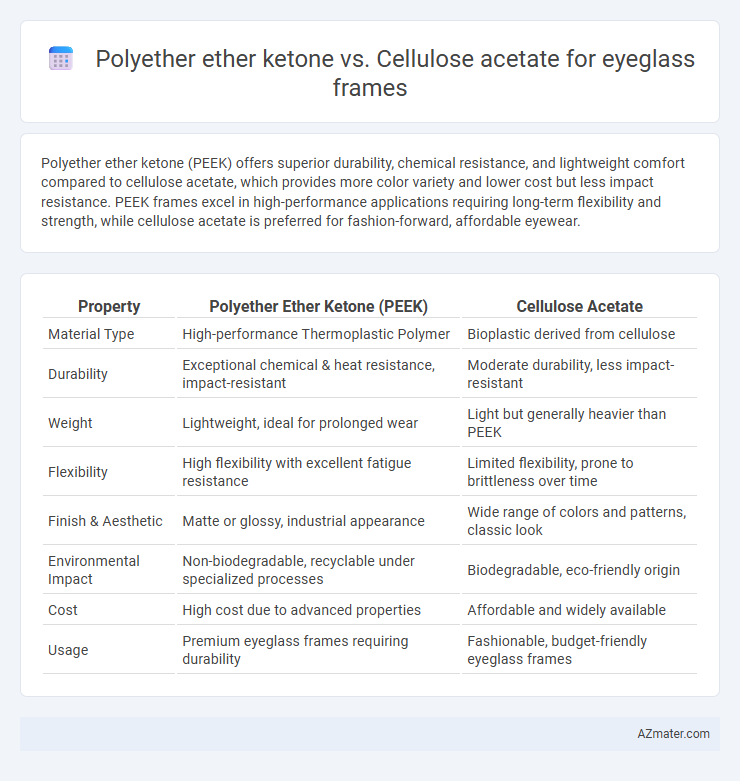Polyether ether ketone (PEEK) offers superior durability, chemical resistance, and lightweight comfort compared to cellulose acetate, which provides more color variety and lower cost but less impact resistance. PEEK frames excel in high-performance applications requiring long-term flexibility and strength, while cellulose acetate is preferred for fashion-forward, affordable eyewear.
Table of Comparison
| Property | Polyether Ether Ketone (PEEK) | Cellulose Acetate |
|---|---|---|
| Material Type | High-performance Thermoplastic Polymer | Bioplastic derived from cellulose |
| Durability | Exceptional chemical & heat resistance, impact-resistant | Moderate durability, less impact-resistant |
| Weight | Lightweight, ideal for prolonged wear | Light but generally heavier than PEEK |
| Flexibility | High flexibility with excellent fatigue resistance | Limited flexibility, prone to brittleness over time |
| Finish & Aesthetic | Matte or glossy, industrial appearance | Wide range of colors and patterns, classic look |
| Environmental Impact | Non-biodegradable, recyclable under specialized processes | Biodegradable, eco-friendly origin |
| Cost | High cost due to advanced properties | Affordable and widely available |
| Usage | Premium eyeglass frames requiring durability | Fashionable, budget-friendly eyeglass frames |
Introduction to PEEK and Cellulose Acetate Eyeglass Frames
Polyether ether ketone (PEEK) eyeglass frames are renowned for their exceptional strength, chemical resistance, and lightweight properties, making them ideal for high-performance eyewear applications. Cellulose acetate frames, derived from natural cotton fibers, offer a sustainable and hypoallergenic option with excellent color variability and a comfortable fit. Both materials provide unique benefits in durability and aesthetics, catering to different customer preferences and functional requirements in the eyewear industry.
Material Composition: Polyether Ether Ketone vs Cellulose Acetate
Polyether ether ketone (PEEK) is a high-performance thermoplastic polymer known for its exceptional strength, chemical resistance, and thermal stability, making it ideal for durable and lightweight eyeglass frames. Cellulose acetate, derived from natural cotton or wood fibers, offers a biodegradable and hypoallergenic option with versatile color and pattern possibilities but lacks the mechanical robustness of PEEK. The material composition of PEEK provides superior impact resistance and longevity compared to the organic, less durable cellulose acetate.
Durability and Longevity Comparison
Polyether ether ketone (PEEK) eyewear frames exhibit superior durability due to their high impact resistance, chemical stability, and thermal endurance, making them less prone to cracking or deformation over time. In contrast, cellulose acetate frames, while popular for their aesthetic versatility, tend to be more susceptible to wear and environmental factors such as UV exposure and moisture, which can cause brittleness and color fading. The longevity of PEEK frames significantly outperforms cellulose acetate, sustaining structural integrity and appearance through prolonged use and harsh conditions.
Weight and Comfort Differences
Polyether ether ketone (PEEK) eyeglass frames are significantly lighter than cellulose acetate frames, enhancing overall comfort during prolonged wear. PEEK's high strength-to-weight ratio reduces pressure on the nose and ears, minimizing fatigue and irritation. In contrast, cellulose acetate, while durable and hypoallergenic, tends to be heavier, which can lead to discomfort over extended periods.
Aesthetic Options: Colors and Designs
Polyether ether ketone (PEEK) eyeglass frames offer a sleek, modern aesthetic with a limited but sophisticated color palette primarily consisting of matte blacks, grays, and metallic hues, emphasizing durability and a high-tech appearance. Cellulose acetate frames provide a broader range of vibrant colors and intricate patterns, including tortoiseshell, transparent, and multi-hued designs, allowing for greater customization and fashion-forward styles. The choice between PEEK and cellulose acetate frames significantly impacts the visual appeal, with cellulose acetate excelling in aesthetic versatility while PEEK prioritizes minimalist and professional looks.
Hypoallergenic Properties and Skin Sensitivity
Polyether ether ketone (PEEK) offers superior hypoallergenic properties due to its chemical inertness, making it highly suitable for individuals with sensitive skin or allergies. Cellulose acetate, while commonly used and lightweight, may often cause irritation or allergic reactions because it contains residual acetate and plasticizers that some wearers find problematic. PEEK's biocompatibility and resistance to sweat and oils reduce the risk of skin sensitivity, positioning it as a preferred choice for hypoallergenic eyeglass frames.
Environmental Impact and Sustainability
Polyether ether ketone (PEEK) offers excellent durability and chemical resistance but poses environmental challenges due to its synthetic, non-biodegradable nature and energy-intensive production process. In contrast, cellulose acetate, derived from renewable plant-based sources like cotton and wood pulp, provides greater biodegradability and a smaller carbon footprint, making it a more sustainable option for eyeglass frames. Choosing cellulose acetate supports eco-friendly manufacturing practices and reduces long-term environmental impact compared to PEEK.
Cost and Accessibility in the Market
Polyether ether ketone (PEEK) eyeglass frames are significantly more expensive than cellulose acetate due to their advanced material properties and high manufacturing costs. Cellulose acetate frames dominate the market because they offer a cost-effective, widely accessible option with ease of production and availability in various styles. The price disparity and market penetration favor cellulose acetate, making it the preferred choice for budget-conscious consumers and mass-market brands.
Maintenance and Care Requirements
Polyether ether ketone (PEEK) eyeglass frames require minimal maintenance due to their chemical resistance and durability, often needing only occasional cleaning with mild soap and water. Cellulose acetate frames are more prone to discoloration and warping from exposure to heat, oils, and solvents, necessitating regular gentle cleaning with specialized solutions and careful handling to maintain their appearance. Proper storage, avoiding extreme temperatures, and using soft microfiber cloths are essential for prolonging the life of both materials, although PEEK frames generally offer superior resilience with less stringent care.
Choosing the Right Frame: PEEK vs Cellulose Acetate
Polyether ether ketone (PEEK) offers superior strength, chemical resistance, and lightweight durability compared to cellulose acetate, making it ideal for long-lasting eyeglass frames. Cellulose acetate provides excellent flexibility, vibrant color options, and biodegradability, appealing to environmentally conscious consumers. Choosing between PEEK and cellulose acetate depends on prioritizing high-performance materials or eco-friendly, customizable aesthetics in eyeglass frame construction.

Infographic: Polyether ether ketone vs Cellulose acetate for Eyeglass frame
 azmater.com
azmater.com